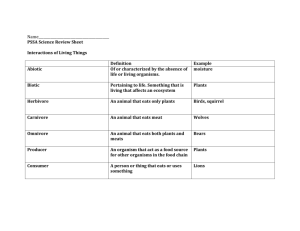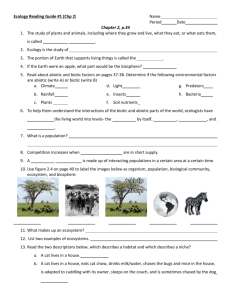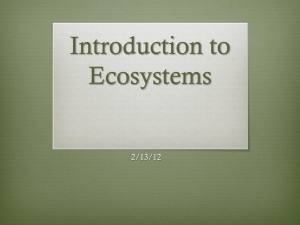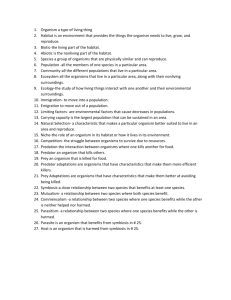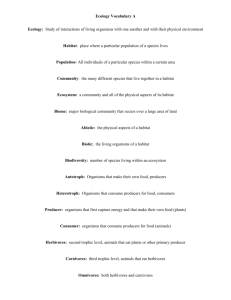ecology keywords - No Brain Too Small
advertisement
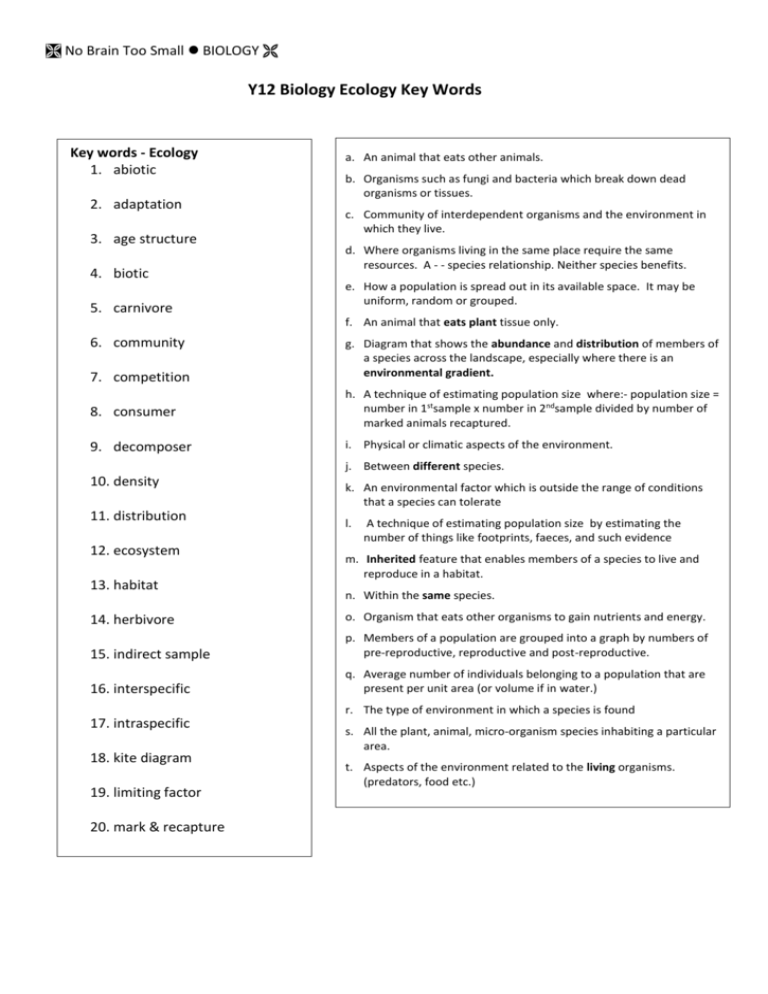
No Brain Too Small BIOLOGY Y12 Biology Ecology Key Words Key words - Ecology 1. abiotic 2. adaptation 3. age structure 4. biotic 5. carnivore a. An animal that eats other animals. b. Organisms such as fungi and bacteria which break down dead organisms or tissues. c. Community of interdependent organisms and the environment in which they live. d. Where organisms living in the same place require the same resources. A - - species relationship. Neither species benefits. e. How a population is spread out in its available space. It may be uniform, random or grouped. f. An animal that eats plant tissue only. 6. community 7. competition g. Diagram that shows the abundance and distribution of members of a species across the landscape, especially where there is an environmental gradient. 8. consumer h. A technique of estimating population size where:- population size = number in 1stsample x number in 2ndsample divided by number of marked animals recaptured. 9. decomposer i. Physical or climatic aspects of the environment. j. Between different species. 10. density 11. distribution 12. ecosystem 13. habitat k. An environmental factor which is outside the range of conditions that a species can tolerate l. A technique of estimating population size by estimating the number of things like footprints, faeces, and such evidence m. Inherited feature that enables members of a species to live and reproduce in a habitat. n. Within the same species. 14. herbivore o. Organism that eats other organisms to gain nutrients and energy. 15. indirect sample p. Members of a population are grouped into a graph by numbers of pre-reproductive, reproductive and post-reproductive. 16. interspecific q. Average number of individuals belonging to a population that are present per unit area (or volume if in water.) r. The type of environment in which a species is found 17. intraspecific 18. kite diagram 19. limiting factor 20. mark & recapture s. All the plant, animal, micro-organism species inhabiting a particular area. t. Aspects of the environment related to the living organisms. (predators, food etc.) No Brain Too Small BIOLOGY 21. microclimate a. An organism that eats both plant and animal tissue (therefore can function in more than one trophic level.) b. A group of organisms from the same species of different ages living in the same area at the same time. c. Birth rate (property of a population) 24. natality d. Similar organisms that can reproduce and produce fertile offspring in nature. (unit of classification.) 25. niche e. An organism that is able to make complex food molecules from simple molecules e.g. plants by photosynthesis. f. Changes in the species composition of a community over time. g. A graph showing the number of individuals surviving against different age categories. h. The role of a species in its habitat. It includes habitat, adaptations to survive there, activity period, mode of life. i. The ability of a species to cope with variation in environmental conditions. 31. quadrat j. A frame used for sampling the species present in a large area. 32. scavenger k. Changes in the composition of a community which occur in response to an environmental gradient. 33. species l. Organism that eats what another animal has killed. 22. mortality 23. mutualism 26. omnivore 27. parasitism 28. population 29. predation 30. producer 34. stratification 35. succession m. Death rate (property of a population) n. Is where one animal kills and eats another animal. o. A community pattern where there is a layering of the foliage of different plant species (and therefore the animals that live on these) into distinct strata. p. Line across a community along which sampling occurs at regular intervals. q. Feeding level of an organism indicated by its position in the food chain. (producers are trophic level one) r. Within an environment there are a number of smaller areas with specific conditions. (e.g. In the soil, organisms would experience different environmental factors than up a tree!) s. Occurs when one organism lives in or on another organism feeding off it but not killing it. t. Ecological relationship between members of two species in which both species benefit. + + 36. survivorship 37. tolerance 38. transect 39. trophic level 40. zonation No Brain Too Small BIOLOGY Ecology answers 1 2 3 4 5 6 7 8 9 10 11 12 13 14 15 16 17 18 19 20 i m p t a s d o b q e c r f l j n g k h 21 22 23 24 25 26 27 28 29 30 31 32 33 34 35 36 37 38 39 40 r m t c h a s b n e j l d o f g i p q k


